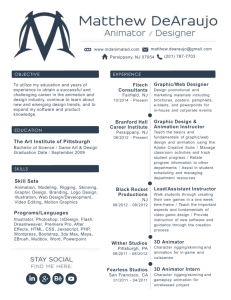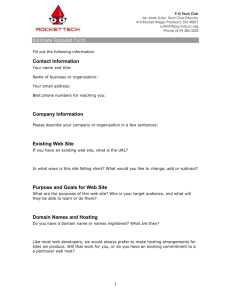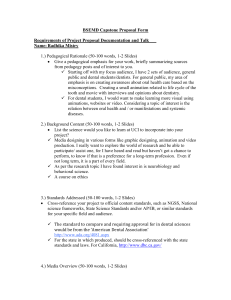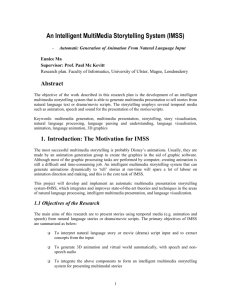ART 260 Oc1 - Oakton Community College
advertisement
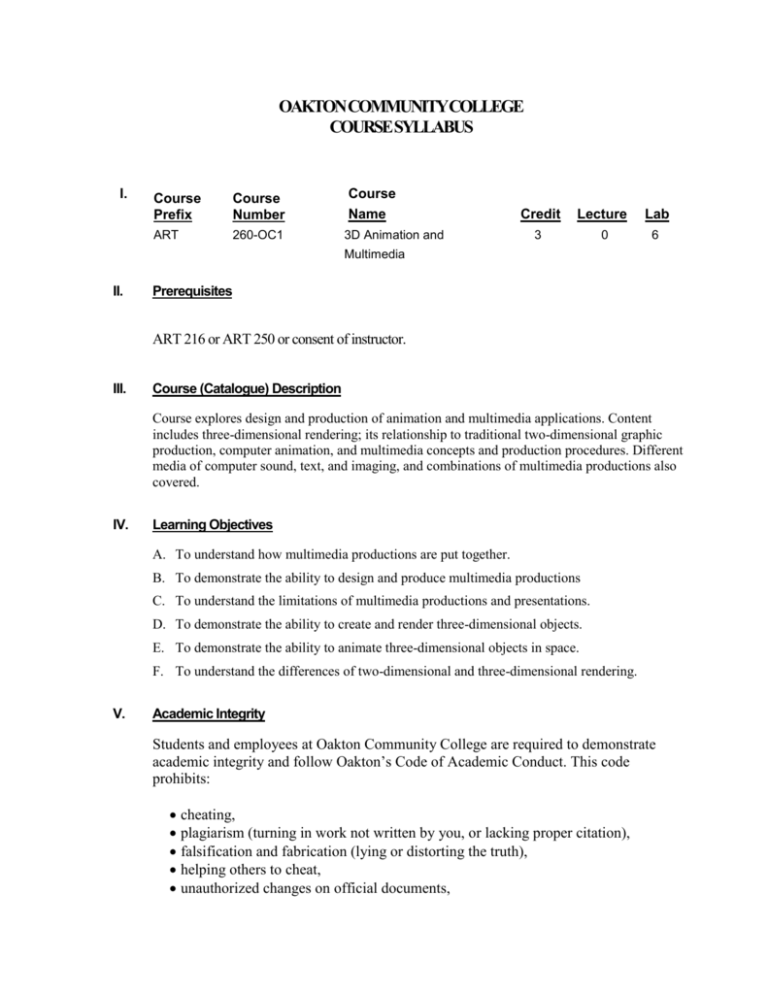
OAKTON COMMUNITYCOLLEGE COURSE SYLLABUS I. Course Prefix Course Number ART 260-OC1 Course Name 3D Animation and Credit Lecture Lab 3 0 6 Multimedia II. Prerequisites ART 216 or ART 250 or consent of instructor. III. Course (Catalogue) Description Course explores design and production of animation and multimedia applications. Content includes three-dimensional rendering; its relationship to traditional two-dimensional graphic production, computer animation, and multimedia concepts and production procedures. Different media of computer sound, text, and imaging, and combinations of multimedia productions also covered. IV. Learning Objectives A. To understand how multimedia productions are put together. B. To demonstrate the ability to design and produce multimedia productions C. To understand the limitations of multimedia productions and presentations. D. To demonstrate the ability to create and render three-dimensional objects. E. To demonstrate the ability to animate three-dimensional objects in space. F. To understand the differences of two-dimensional and three-dimensional rendering. V. Academic Integrity Students and employees at Oakton Community College are required to demonstrate academic integrity and follow Oakton’s Code of Academic Conduct. This code prohibits: cheating, plagiarism (turning in work not written by you, or lacking proper citation), falsification and fabrication (lying or distorting the truth), helping others to cheat, unauthorized changes on official documents, COURSE SYLLABUS (GENERIC) Page 2 ART 260 pretending to be someone else or having someone else pretend to be you, making or accepting bribes, special favors, or threats, and any other behavior that violates academic integrity. There are serious consequences to violations of the academic integrity policy. Oakton’s policies and procedures provide students a fair hearing if a complaint is made against you. If you are found to have violated the policy, the minimum penalty is failure on the assignment and, a disciplinary record will be established and kept on file in the office of the Vice President for Student Affairs for a period of 3 years. Details of the Code of Academic Conduct can be found in the Student Handbook. VI. Outline of Topics I. History of Animation Prehistory Reynaud Edison Kinetscope The Record of a sneeze Lumiere brothers Cinematograph “Workers leaving the Lumiere factory” Edward Muybridge Animal locomtion Human locomotion Start of animation Cohl Mccay Gertie the dinosaur Interacting Disney “Steamboat Willie” “Pinochio and Fantasia” Principles of animation and the history of the studio Animation and the computer The space odessy “20001” “Toy story” D:\116105968.doc COURSE SYLLABUS (GENERIC) ART 260 “Shrek” Major changes from traditional animation to computer animation II. Animation Definition of Animation Twelve Principles of Animation Camera Production Setting views Animation paths Key frames Modification of paths Frame numbers Sequences Timing Editing Lighting Resolution III. Multimedia Basic Principles Audio Production File types Sound Standards Midi Hardware Boards Midi hardware Video Monitor Quality Refresh rates Interlacing Convergence Inputs and Manipulation Frames per second D:\116105968.doc Page 3 COURSE SYLLABUS (GENERIC) ART 260 Titles and type Editing and effects Analog and Digital Cameras Storage Magnetic CD-ROM and DVD Hard drive Assemblies and Prodution Planning and Storyboards Multimedia work area Power Testing and preview Publishing Diskettes CD-ROM and DVD Video Cassettes IV. Three-Dimensional Rendering History of computer graphics Image production Vector Rasterization Resolution Pixels per inch Print attributes Image sizing Two-dimensional qualities Balance, rhythm and harmony Tone, texture, and form V. Modeling Drawing objects Line Polygon Rectangle Box D:\116105968.doc Page 4 COURSE SYLLABUS (GENERIC) ART 260 Arc Ellipse Cone Cylinder VI. Drawing in three-dimensional space Setting points Absolute vs. Relative Rotation Center of field VII. Modifying Deletion Estrude Lathe Linking Polygon meshes Copying objects Grouping Open and closing Paste and imbed Welding Corner Moving points VIII. Rendering Texture mapping Scaling textures Color palettes Surface qualities Smoothing Join objects Bump texture Material libraries Lighting Positioning Types of lights D:\116105968.doc Page 5 COURSE SYLLABUS (GENERIC) Page 6 ART 260 Shadows Color of light IX. Options Final aspect and resolution Viewing X. Alpha Channels XI. Reflections VII. Methods of Instruction This course will be presented using a combination of lectures, slide presentations through DVD’s supplied by the college.. VIII. Course Practices Required A. Comment on student work B. Upload all assignments into the critique area of the course site C. Answer all notebook question IX. Instructional Materials A. Computer capable of render ing movies made in Carrara and Pinnacle software. B. X. Carrara Versions 8,9 or 10 and Pinacle Movie maker ver9 and 10 Methods of Evaluating Student Progress A. Grading The final grade will be based upon the following elements 1. Critiques 2. Notebooks 3. Work in progress or benchmarks 4. Comments on student work Each assignment will have a point value. As you do the assignments the points will add up to your final grade Assignments not turned in on time will have a 10 percent penalty in terms of points given.: B. Clips will be evaluated in the following manner: 1. Modeling, Shading quality and editing 2. Animation quality and the use of the twelve principles of animation 3. Technical quality relating to issues of compression, rendering and pixalization D:\116105968.doc COURSE SYLLABUS (GENERIC) Page 7 ART 260 Images will be evaluated in the following manner: XI. 1. Technical quality 2. Craftsmanship 3. Use of modeling and shading techniques Other Course Information: If you have a documented learning, psychological, or physical disability you may be entitled to reasonable academic accommodations or services. To request accommodations or services, contact the ASSIST office in the Learning Center. All students are expected to fulfill essential course requirements. The College will not waive any essential skill or requirement of a course or degree program. D:\116105968.doc



